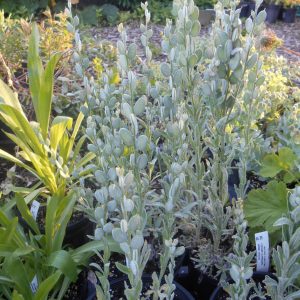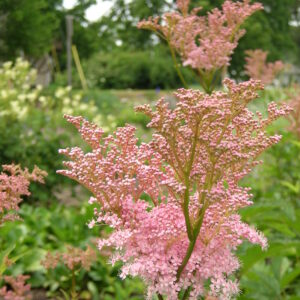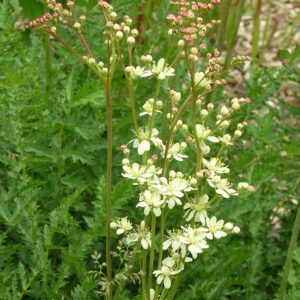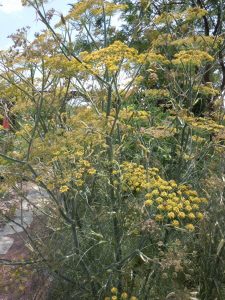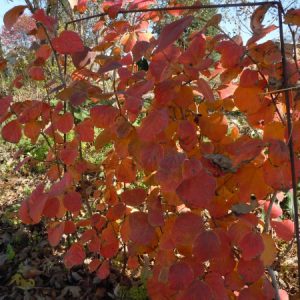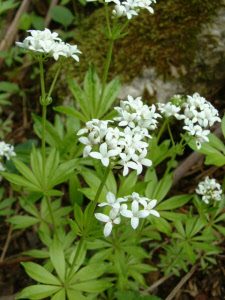Shop
Showing 313–320 of 788 results
-
Fibigia clypeata Roman shields Z 5-8
Yellow spring flowers in early summer, followed by small, oval “silver dollars” on erect stems. “What is that?” many customers ask.
Yellow spring flowers in early summer, followed by small, oval “silver dollars” on erect stems. “What is that?” many customers ask.
Size: 18” x 12-15”
Care: sun well-drained soil Self-seeds freely
Native: Southern Europe
Wildlife Value: source of nectar and pollen for bees and other insectsUsed for their ornamental seed pods. Harvest either when 1st form for fuzzy grey-green color or when mature with outer skin removed for translucent, silver shield. In gardens before 1753.
-
Filipendula rubra ‘Venusta’ Queen of the prairie Z 3-9
Extraordinary frothy pink plumes, like cotton candy, blooming in midsummer
Extraordinary frothy pink plumes, like cotton candy, blooming in midsummer
Size: 4-6’ x 4-5'
Care: sun to part shade in moist well-drained to moist soil
Native: US East coast west to MN s to MO and NC, Wisconsin native
Wildlife Value: This creates pollen but not nectar limiting the pollinators to bees and flies (Butterflies and wasps want nectar.).
Awards: Award of Garden Merit from England’s Royal Horticultural Society.Name is Latin filum pendulus meaning hanging by thread referring to threads on the roots of another species.
Wildlife value: This creates pollen but not nectar limiting the pollinators to bees and flies (Butterflies and wasps want nectar.)
Meskwaki Indians used the species for heart ailments and as an aphrodisiac. Although the plant’s name has been changed five times, the species was 1st described in 1768. Robinson, Rhodora, v. 8 pp. 202-205 (1907). “Filipendulina, a New Binomial,” The flowers of this cultivar are darker than the species. Described by German botanist Andreas Voss (1857-1922). -
Filipendula vulgaris syn. F. hexapetala Dropwort or Meadowsweet Z 3-9
In early summer bundles of milk white ball-shaped buds and open blossoms atop clumps of finely-cut, fern-like leaves, both flowers and foliage fragrant, early to mid-summer.
In early summer bundles of milk white ball-shaped buds and open blossoms atop clumps of finely-cut, fern-like leaves, both flowers and foliage fragrant, early to mid-summer.
Size: 24" x 18"
Care: sun in moist to moist well-drained soil
Native: Europe, north and central Asia
Wildlife Value: attracts bees, beetles and fliesFilipendula is Latin from filum meaning thread and pendulus meaning hanging, small tubers hang by threadlike roots. In the 1600’s Nicholas Culpepper described Meadowsweet’s medicinal uses as curing bladder problems, throat, lung diseases and “the falling sickness.” Filipendula vulgaris also remedied bloated stomachs “dissolving and breaking the wind.”
-
Foeniculum vulgaris ‘Purpureum’ Bronze fennel Z 4-9
Yellow blooms on flat-topped umbels in late spring into summer, features dusky purple, feathery, compound, aromatic purple leaves with needle-like segments.
OUT OF STOCK
Yellow blooms on flat-topped umbels in late spring into summer, features dusky purple, feathery, compound, aromatic purple leaves with needle-like segments.
Size: 4-5’ x 2-3’
Care: sun to part shade in well-drained soil.
Native: Mediterranean
Wildlife Value: attracts bees and birds. Nectar plant for Swallowtail butterflies.Ancient Egyptians used fennel as food and medicine. Considered a snake bite remedy in ancient China. During the Middle Ages people hung it over doorways to drive away evil spirits. Fennel is also associated with the origin of the marathon. Athenian Pheidippides carried a fennel stalk on his 150-mile, 2-day run to Sparta to gather soldiers for the battle of Marathon with Persia in 490 B.C. The battle itself was reportedly waged on a field of fennel. Miller’s The Gardeners Dictionary, eighth ed. 1768.
-
Fothergilla gardenii Dwarf fothergilla Z 5-9
Honey-scented ivory bottlebrushes, made up of long stamens, 2” tall in spring, leaves turn jewel toned red, purple & orange in fall.
Honey-scented ivory bottlebrushes, made up of long stamens, 2” tall in spring, leaves turn jewel toned red, purple & orange in fall.
Size: 2-3’ x 2-6’
Care: sun to part shade in moist well-drained, acidic soil. Pruning not recommended.
Native: NC south to MS & west to TN
Awards: Missouri Botanic Garden Award of Merit, Great Plant Pick Award from Elisabeth Carey Miller Botanical GardenCollected before 1750’s by John Bartram and offered for sale in Bartram Garden’s 1783 Broadside, America’s 1st plant catalog. Genus named to honor Dr. John Fothergill (1712-1781) avid English plant collector & friend of Peter Collinson. And species named to honor Dr. Alexander Garden, (1730-1791) a colonial Scotsman who lived in the Carolinas.
-
Fragrant Garden for sun
ARCHIVED Note: This collection is a not currently for sale. This is an archive page preserved for informational use. Fragrant Garden for sun Size: Height x width * Bloom color 3 Agastache foeniculum – Anise hyssop 2-3’ x 12” purple 1 Buddleja davidii – Butterfly bush […]
ARCHIVED
Note: This collection is a not currently for sale. This is an archive page preserved for informational use.
Fragrant Garden for sun Size: Height x width * Bloom color
3 Agastache foeniculum – Anise hyssop 2-3’ x 12” purple
1 Buddleja davidii – Butterfly bush 6’ x 4’ purple
1 Clematis ternifolia – Sweet autumn 15-20’ x 6-10’ white
3 Lavandula angustifolia ‘Munstead’ 12-18” x 12-18” lavender
1 Lilium auratum – Gold band lily 2-5’ x 12” white/yellow
1 Paeonia ‘Sarah Bernhardt’ 36” x 36” pink
1 Monarda didyma – ‘Cambridge Scarlet’ beebalm 3-4’ x spreading red
3 Sporobolis heterolepsis -Prairie dropseed 2′ x 2′ pink/brown
3 Thymus serphyllum – Creeping thyme 3″ x 24″ purpleAll plants are perennials.
If planted together in one garden these make a 28 square foot garden. *Most of these plants get wider over time by spreading roots or by self-seeding . -
Gaillardia aristata Blanket flower Z 3-8
Yellow and red daisy petals surround red cones non-stop, June-September, a true winner.
ARCHIVED
Note: This is a plant not currently for sale. This is an archive page preserved for informational use.
Yellow and red daisy petals surround red cones non-stop, June-September, a true winner.
Size: 30” x 24”
Care: sun, well-drained soil
Native: Western US, Canada to Arizona
Awards: Oklahoma ProvenNamed for French botanist, M. Gaillard de Marentonneau. Found by Meriwether Lewis July 6, 1806, along the Blackfoot River on “dry hills” in Montana. Blackfoot natives used Blanket flower to absorb soup and waterproof rawhide. The entire plant toasted and pounded, mixed with bear grease cured mumps. It prevented balding and cured eye ailments in horses.
-
Galium odoratum Sweet woodruff, Bedstraw Z 4-8
Whorls of fine textured leaves, like spokes of a wheel, with white blooms in spring lighting up the shade
Whorls of fine textured leaves, like spokes of a wheel, with white blooms in spring lighting up the shade
Size: 6-12" x 18" spreading
Care: shade to part shade in moist to moist well-drained soil.
Native: Europe and Mediterranean areaCalled “Bedstraw” because, according to legend, Mary rested on hay of Bedstraw on Christmas. May wine made an ancient herbal remedy: handful of dried and crushed leaves plus fresh lemon juice steeped in wine for 3-4 hours “makes a man merry and (is) good for the heart and liver.” Garlands hanging in houses in summer “coole and make fresh the place, to the delight and comfort of such as are therein.” per English herbalist Gerard, 1633. Dried branches give a grassy vanilla fragrance, used in sachets and potpourris, as an insect repellant and to make grey-green dyes.

